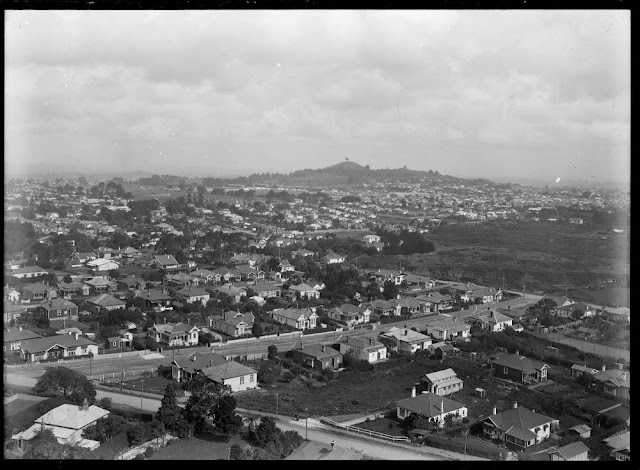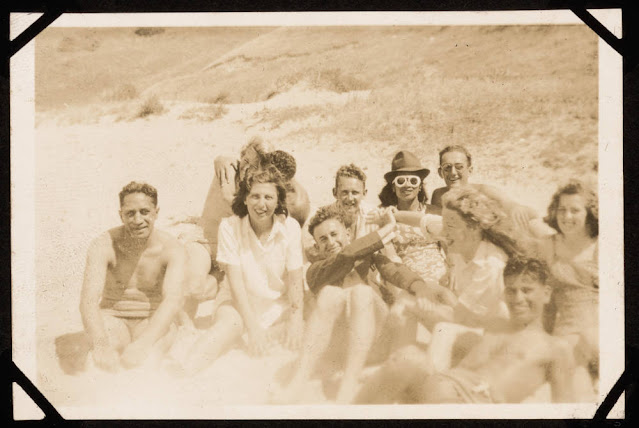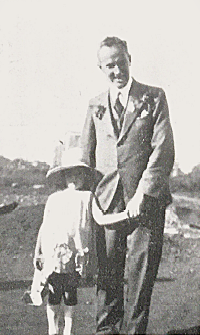‘We Are Pioneers’ Auckland Training College, 1926 - 1946
In 1925, a building was erected at 72 Epsom Avenue. Where previously the area was littered with gorse and rocks, and popular among local children for playing games, the scoria field was now to accommodate Auckland Training College.
Auckland Training College officially relocated from Wellesley Street to 72 Epsom Avenue in 1926. But teacher trainees entered the building for the first time in 1925, having carried equipment there from Wellesley Street. The trainees celebrated the occasion with dancing and singing, the College principal leading the way.
 |
| Image: H.G. Cousins, Principal of Auckland Training College from 1917 to 1928. From Manuka 1956 (Jubilee Edition). |
From 1926 to 1946, the feeling of camaraderie which prompted trainees to dance with their principal would define the experience of attending Auckland Training College. Indeed, the student community of Auckland Training College would thrive despite such challenges as the Great Depression or Second World War. But why was attending Auckland Training College from 1926 to 1946 such a socially fulfilling experience? This article hopes to answer that question. This article is also the first of three to investigate how political and organisational decisions affected the student community at Auckland Training College (or Auckland Teachers College, as it came to be known) from 1926 to 1986.
A Glorified Secondary School
First, the experience of attending Auckland Training College was designed to be socially fulfilling. As explained by Herbert Cousins, principal of Auckland Training College from 1919 to 1929, the College was meant to produce well-rounded individuals; and socialising trainees was critical to that goal. Consequently, the College’s courses were structured to encourage trainees to socialise and broaden their horizons.
Not coincidentally, this meant the experience of attending Auckland Training College was sometimes reminiscent of attending secondary school. From 1926 to 1964, trainees attended classes at College from 9:00am to 3:30pm, Monday through Friday. Their timetables allocated time to eating, socialising, assemblies, and participating in clubs and sports, and they generally did not choose what subjects they studied. Trainees also travelled between classes and activities in small groups of 25 to 30, called ‘sections.'
In addition, trainees were subject to strict rules. For instance, men and women had to enter the College’s main building through separate entrances and congregate in separate common-rooms. Additionally, the standards of dressing at College were so high that some trainees had to purchase clothes to attend. These rules were, in part, products of their time. But trainees were also closely supervised because from 1926 to 1946 (and until 1983), they were employees of the Auckland Education Board; paid to study.
The next challenge which might have fractured the student community of Auckland Training College was the Great Depression. The economic crisis cancelled the College’s tournament with Wellington Teachers Training College in 1931, and forced the College to close for the duration of 1934. But the trainees worked together to ensure that attending College was a positive experience, nonetheless. From 1931, for instance, the staff and trainees collaborated to stage a Christmas party for the relief-workers charged with improving their campus. In addition, trainees’ allowances were reduced in 1932. Still, Manuka reported on the 1932 annual College ball as follows: “The rainbows have adopted an inferiority complex since they saw some of the ladies’ dresses…” Finally, when Auckland Training College reopened in 1935, trainees returned to socialising with gusto. At the first meeting of the Dramatic Club in 1935, there were so many attendees that it was decided to divide the club into eight.
But 1934 was not the last time that 72 Epsom Avenue would close to trainees. In 1941, the College’s campus was requisitioned by the Auckland Hospital Board, and classes were relocated to the University College of Auckland. The experience was trying for trainees, as University students gawped at the women trainees during their Physical Education classes and subsequently stole some of those women’s exercise clothes and hung them from the University’s clock-tower.
Still, Duncan Rae might have learnt something from the incident, because when 72 Epsom Avenue was requisitioned again in 1942 (this time by New Zealand’s Armed Forces), classes were relocated to the Normal School adjoining 72 Epsom Avenue. According to one student, the experience was uncomfortable: “You sat with your notebook on your knee [during classes]... And I remember the toilets, were those child-size toilets.” But the student community of Auckland Training College refused to be fractured, even with most male trainees leaving for mandatory military training in 1942. The women students competed against their teachers in basketball. Other students organised a ‘mock court’ where staff-members submitted to be tried for such crimes as “having no fixed abode” (Duncan Rae). Thus, staff assisted in keeping the student community afloat, and organised weekly assemblies at the Crystal Palace Cinema on Mount Eden Road.
Triumphs and Omens
In summary, from 1926 to 1946, the student community of Auckland Training College was close-knit. First, because courses at Auckland Training College were designed to encourage trainees to socialise. Second, because such challenges as the Great Depression and Second World War required a coordinated response from trainees. But the collegial atmosphere at Auckland Training College could not have survived the 1930s and 1940s without staff and trainees committing themselves to keeping that atmosphere alive. Indeed, it seems that from 1926 to 1946, staff and trainees shared a vision of Auckland Training College; it was an institution meant to socialise students and broaden their horizons. As a result, attending Auckland Training College was a positive and socially fulfilling experience for most trainees.
However, even from 1926, there were clues as to what might eventually fracture the student community of Auckland Training College. In 1927, a trainee wrote the following in Manuka: “The distance between College and [University] has reduced the College to little more than a secondary school, to be left at 3:30pm for most of us have to be at a 4 o’clock lecture.” This trainee was writing on behalf of the small, but growing, number of trainees attending College and University simultaneously (so they might graduate with a teacher’s qualification and a University degree). These trainees struggled to attend social events at Auckland Training College. For instance, in 1932, the Auckland Training College Sketch Club reported that attendance at meetings had fallen towards the end of the year due to University examinations.
In addition, trainees who attended College and University simultaneously were traversing institutions with radically different objectives. Auckland Training College aimed to provide trainees with a holistic education, and to equip them with skills which would serve them well as teachers (skills which would be difficult to assess by traditional means). Meanwhile, University prioritised depth of experience over breadth of experience, and encouraged students to distinguish themselves academically. Some trainees who attended College and University were able to reconcile these different approaches to education. But others could not understand, or accept, the more abstract objective of Auckland Training College and its courses. Even from 1926, there were clues that trainees were beginning to expect from College an experience different from that which College was engineered to provide.
As discussed in the second article in this series, this change in attitude would combine with several other pressures to force Auckland Training College to subtly change from 1947 to 1964.
#You can read the rest of Cameron's articles here:
Part 2: The Rocks of Indifference, 1947-1964
Part 3: 'The Corpse's frequent kicks, 1965-1986
Author: Cameron Gregan, Auckland History Initiative Summer Scholar
Cameron is completing a Bachelor of Laws and Bachelor of Arts conjoint, majoring in English. He is interested in pursuing a career in primary teaching.
Cameron researched the story of Auckland Teachers College from 1926 to 1986, and how the institution’s student community was adversely affected by political and organisational decisions made during that time-period. The story of Auckland Teachers College, and its Epsom campus, was of interest to Cameron given the campus’ recent closure. By drawing on student magazines and testimonies from the time-period, Cameron discovered that Auckland Teachers College was fractured by the institution transforming from a ‘glorified secondary school’ into a ‘pseudo-university.’
Cameron would like to thank his supervisors, Dr Jess Parr and Professor Linda Bryder, for supporting his research journey. In addition, he would like to thank the University of Auckland’s Cultural Collections team and Auckland Libraries for assisting his search for primary sources. Finally, he would like to thank the other members of his Auckland History Initiative cohort for their feedback and encouragement.
References:
Auckland College of Education Old A's Oral History Project recordings. MSS & Archives 2024/02, folder 1/14, p2. Special Collections, Te Tumu Herenga | Libraries and Learning Services, University of Auckland.
Louise Shaw, Making a Difference (Auckland: Auckland University Press, 2006), p61.
Manuka: Occasional Magazine of the Auckland College of Education, School of Primary & Early Childhood Education (Manuka) (1926), p6. Special Collections, Te Tumu Herenga | Libraries and Learning Services, University of Auckland.
Old A's Oral History Project recordings. MSS & Archives 2024/02, folder 1/3, p4.
Old A's Oral History Project recordings. MSS & Archives 2024/02, folder 1/3, p12.
Old A's Oral History Project recordings. MSS & Archives 2024/02, folder 1/16, p3.
Old A's Oral History Project recordings. MSS & Archives 2024/02, folder 1/30, p2.







Comments
Post a Comment
Kia ora! Please leave your comment below.